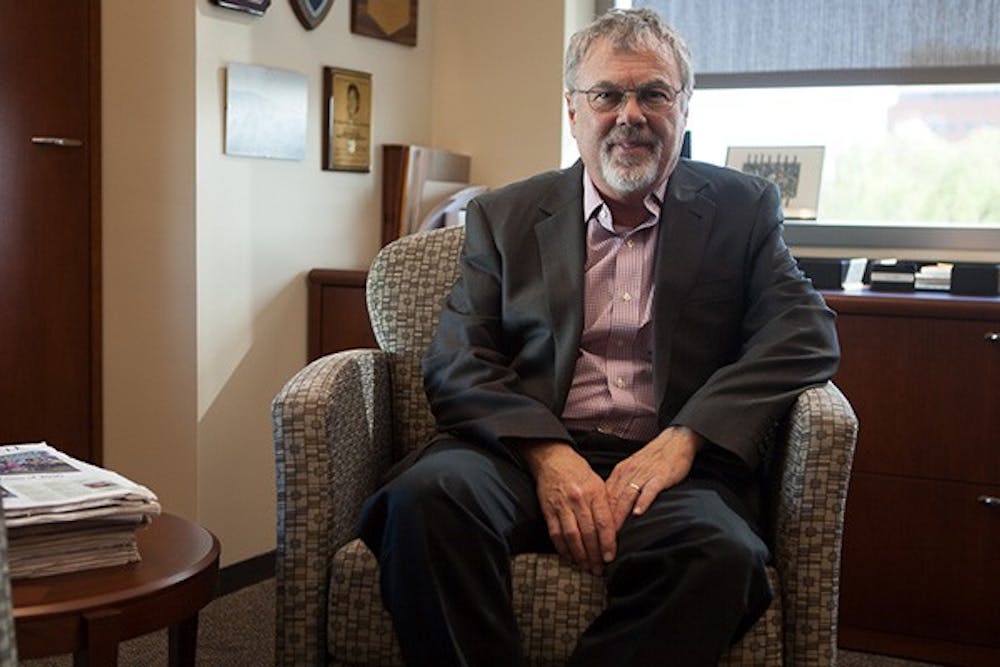 Provost Robert E. Page Jr. poses in his office. Page collaborated with an international team have answered what genetic differences there are between male and female bees, and this gives insight into human genetic mysteries, such as Alzheimer's. (Photo by Ryan Liu)
Provost Robert E. Page Jr. poses in his office. Page collaborated with an international team have answered what genetic differences there are between male and female bees, and this gives insight into human genetic mysteries, such as Alzheimer's. (Photo by Ryan Liu)After years of research and international collaboration, Provost Robert E. Page Jr. and his colleagues have solved a crucial genetics mystery: sex determination in bees. Although the issue seems small-scale, it has been left unsolved by geneticists for 200 years, and the results could lead to humans being able to breed honeybees for favorable qualities in the future.
Page first became interested in bee genetics in the mid-1970s, while he was in graduate school at the University of California, Davis, after a professor named Harry Laidlaw — a man Page calls his mentor — developed instruments to artificially inseminate queen bees. This seemed to be a breakthrough, until the larvae began to be consistently eaten by the other worker bees.
“I was fascinated with this, and I started figuring out ways to maximize selection and minimize the loss from bees being homozygous,” he said. “The worker bees would eat the homozygous gene, they could detect it.”
Page soon began his work to discover the genetic reason behind the larvae’s deaths, until other articles redirected his research.
“The author said the most important question was explaining in hymenoptera (insects) how this single-locus sex determining works,” Page said. “So that occupied my mind until about 1988, when I was reading the paper and they were talking about how they could map genes in tomatoes. I thought, ‘Gee maybe we could figure out how to map genes in honeybees, and if we could map it, maybe we could figure out what it is.’”
Single-locus sex determining refers to the genetic process in which honeybee eggs are created as male or female, with multiple alleles at a single gene location. This process is unique because most organisms determine sex on chromosomes.
With this new question in mind, Page returned to UC Davis with a determination to find the answer, he said.
At the same time, Martin Beye was working on this same issue at his laboratory in Germany. Page traveled to Germany in 1996 on a Humboldt Research Award, and the two researchers soon discovered their similar interests.
“When I met Martin and learned he had also been working on the sex locus, and we compared notes and began talking, we decided that we could do what was called chromosome walking,” he said. “It was a difficult job, and it was really Martin’s tenacity and ingenuity that made it possible.”
Chromosome walking is a method of cloning used to identify the function of different genes along a chromosome.
After working together in Germany, Beye was also awarded a fellowship to return to the U.S. with Page in 2000. Eventually, the scientists established an international team of researchers in Germany, France and the U.S., including ASU Bee Specialist Michael Fondrk. Page said he still collaborates with members of this team, especially Beye.
“That’s how science works: It’s a village working on single problems,” Page said. “You can’t do it by yourself anymore. You have to have a group of people with different skills and talents.”
Beye, now a professor of evolutionary genetics at the Heinrich Heine University of Düsseldorf, said the international aspect of the project made it successful and enjoyable.
“It’s fun if it’s international,” Beye said. “You get in touch with different people and different ways of thinking, not because they are from different places but because they are from different fields. … We were going from evolutionary questions to genetic questions, also with some mathematical modeling, so that was really cool.”
Both scientists agreed their results will create a new textbook explanation for how genetics systems can work and could be integrated into genetics courses at ASU and abroad. Specialists in both of their countries have expressed enthusiasm over the discovery.
Gro Amdam, a professor in ASU’s School of Life Sciences and Pew Biomedical Scholar, said the implications of Page and his colleagues’ work go beyond the classroom and can help solve issues in human genetics.
“Among the social insects, the honey bee has special honors: an amazingly beneficial and important species for agriculture, a model for studies in neuroscience and with a potential to help us understand how we can age with healthy bodies and brains,” she wrote in an email.
After a publishing a series of their work in Current Biology journal at the end of 2013, Beye and Page said they plan to meet again in three weeks to continue their collaboration.
Reach the reporter at elmahone@asu.edu or follow her on Twitter @mahoneysthename




